soziale stadt - bundestransferstelle
besonderem Entwicklungsbedarf - Soziale Stadt"
Cottbus Sachsendorf-Madlow |
|||||||
|
Kerstin Jahnke |
|||||||
1. Nature of the Area 
In 1999 the biggest panel-construction or "Plattenbau" housing estate in Brandenburg, Sachsendorf-Madlow, was included as a model area in the "Districts with Special Development Needs - the Socially Integrative City" programme. In appearance, demographic development, and the social and economic problems of recent years, this district in South Cottbus is paradigmatic for this type of area, characteristic of many towns and cities in East Germany.
Sachsendorf-Madlow was built between 1974 and 1986 in the context of the state-planned development of the Lausitz "energy region," primarily to house the workforce of Jänschwalde power station and the Cottbus lignite combine, but it also offered alternative accommodation to the run-down inner city. 12,000 dwellings were erected in four stages, constituting the biggest continuous industrialized construction housing estate in the present-day state of Brandenburg, which was home to up to 30,000 people until 1993.
Four residential neighbourhoods are to be distinguished, corresponding to the four building stages, and which surround the old core of the community with its single-family housing. The neighbourhoods are characterised by five and six-storey perimeter block development. Eight and eleven-storey tower blocks are dominant elements in the central area and mark the entrance situation to the district. While some neighbourhoods permit "green-oriented living," the unmodernised northern "slab buildings" are monotonously massive. Even before 1989, cost-cutting had limited the commercial, sporting, and recreational infrastructure to a minimum, so that the district became a typical residential and dormitory suburb for a fully-employed industrial society, which, after the change in political regime, offered little scope for the new conditions spanning unemployment and growing affluence and the consequent differentiation in life styles.
The residential area centres of the northern east-west boulevard, Gelsenkirchener Allee, with its service and shopping amenities, which in 2001 was highlighted by a striking tent roof as the focus and forum of the neighbourhood. Despite the central location and the upgrading of the square, tenant fluctuation and commercial space vacancies are conspicuous. With low purchasing power, custom has been drawn off by inner city facilities and the Lausitzpark shopping centre beyond the motorway, which offers retailing, cinemas, and services for the whole of Cottbus "ante portas." Since 1994 the Cottbus campus of the Lausitz Technical College has been established in a formerly closed barracks. The college provides five programmes of study including social studies and civil engineering.
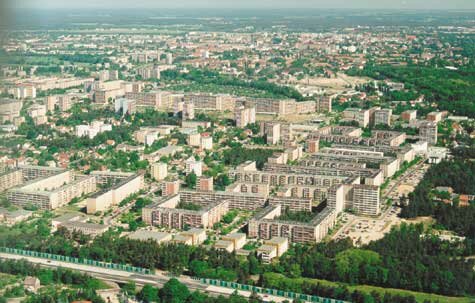 |
| Eastern part of the model area with the "green centre" (Source: Foto Kliche, Cottbus) |
Over the past decade, the district has experienced an almost complete turnabout in desireability, and residents have reacted in different ways to the changes in their social and economic conditions and to the image of the area in which they live. Where there had once been a high demand for housing because of satisfaction with standards, the situation is now dominated by high vacancy rates. Full employment in the "energy region of the GDG" has given way to high unemployment, and income differentiation combined with a relaxed housing market has induced many who have "made it" to leave, whereas those who have moved in are often people who cannot afford the cost of housing elsewhere.
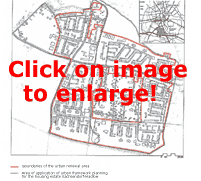 |
Boundaries of the model area Sachsendorf-Madlow (Source: Integratied Plan of Action 2001, StadtBüro Hunger; revised) |
Some 17,700 people currently live in Sachsendorf-Madlow, 43% fewer than in 1993. Despite high outmigration - the migration balance for 2000 alone was -8% - the population of the estate is still young even almost three decades after the first residents moved in.
The share of residents in the age group 35-45 and of young people is higher than average - still a consequence of the housing occupancy policy pursued in the GDR, which primarily accommodated young families with children in Sachsendorf-Madlow. Socio-economic conditions had corresponded largely with the overall situation in the city. However, in recent years a marked decline has occurred, also reflected in the lower educational level of the local population.
2. Main Problems and Development Potential 
Against the background of a declining population and in view of the general economic depression and high tenant fluctuation, the main problems are vacant dwellings, unemployment, dilapidation and increasing social erosion.
The persistent housing surplus in the region as a whole has increased vacancy rates in pre-fabricated housing: an average rate of 26% has a deleterious impact on living conditions, disrupts neighbourly networks, and encourages remaining residents to think about moving. And where dwellings are vacant, shops close down for lack or custom and the existence of schools is called in question. The relatively low level of rehabilitation and modernisation undertaken in Sachsendorf-Madlow in comparison with other major housing estates in Cottbus also has a negative effect, although the majority of residents are now heavily dependent on low rents. These circumstances threaten the economic future of all housing companies.
High unemployment and a lack of economic activities in the district result in lower incomes and purchasing power. Owing to dramatic job cuts not yet compensated in the district or the region, the unemployment rate in Sachsendorf-Madlow has risen to over 26%, far higher than the 17% average for Cottbus as a whole. The high level of long-term unemployment - 40% - is particularly critical. The people affected often see themselves as the losers in societal change and without prospects for the future. Since there are no signs of a local economy over and above the service sector developing, or any major investment projects, little positive stimulus can be expected to come from within the district itself.
Demography and Social Space
|
Sachsendorf-Madlow (1) |
Cottbus |
|
|
Size |
230 ha |
15 030 ha |
|
Population |
19 620 |
108 200 |
|
Population decline (1995–2000) |
30.7 % |
11. 6 % |
|
Average household size |
2.11 pers. |
2.11 pers. |
|
Number of dwellings |
12 057 |
60 800 |
|
Vacant dwelling units |
3 040 |
9 000 |
|
Housing benefit recipients |
6.5 % |
4.5 % |
|
Unemployment rate |
n.a. |
16.5 % |
|
Social assistance recipients |
5.4 % |
3.2 % |
|
Foreign population |
3.8 % |
2.8 % |
|
Population under 18 |
24.1 % |
18.6 % |
|
Population 60 and older |
15.2 % |
24 % |
|
(1) Statistical districts 0231-0235 |
||
The large-scale service facilities established on the city periphery in the past decade have lessened the attractiveness of the district for investors and hampered the establishment of local jobs. The economic prospects for service and commercial firms in Sachsendorf-Madlow are adversely affected by the strong competition from the new shopping centre located immediately beyond the southern limits of the city, which devalues land resources in the estate.
The thinning out of the infrastructure in supply and service facilities and in the cultural field diminishes the residential desirability of the area. The poor local services and supply situation has a major adverse impact on dwelling quality, encouraging people to move away and discouraging them from moving in. Reductions in the formerly good range of municipal cultural and recreational activities on offer, which are now largely in the hands of associations and clubs, are regarded as a loss in the quality of life, especially when there is more "enforced leisure" due to unemployment.
Particularly serious is the fact that these problems are closely interlinked and mutually dependent. To rescue the area from the spiral of decline caused by a problem-induced loss of attractiveness and by worsening problems, the municipality has decided to tackle the various factors simultaneously and with the means at its disposal, through constructional, social, community, and economic initiatives - in other words, in the framework of a cross-authority and cross-issue, integrated action concept. A range of positive development resources is indeed available for this purpose.
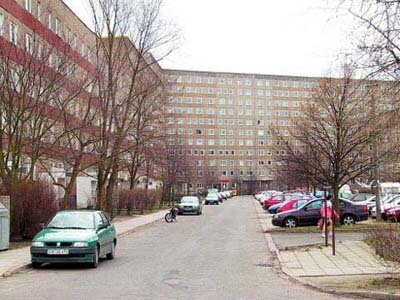 |
Problem housing quality: Low degree of modernisation and monotonous structures (Source: IRS, Erkner) |
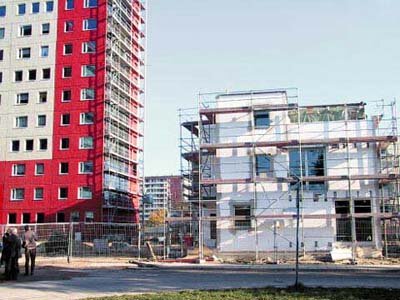 |
Redevelopment potential: Recycling of prefabricated panels to build suburban villas (Source: IRS, Erkner) |
The location of the estate and the low density of development with generous open spaces between buildings offer a good point of departure for improving open and public spaces. Landscaping in collaboration with various groups of residents can ameliorate the amenity quality and appearance of the estate. This has an internal impact on quality for different age and interest groups and externally on the image of the district.
The decision that has been taken for scaled-down and quality redevelopment offers opportunities for reconfiguration on the basis of functional redefinition and for the necessary spatial and structural reorganisation. Reappraisal of the district in the overall context of the city will permit adjustment to medium-term quantitative requirements and a concomitant improvement in quality for residents. First examples of how the demolition of a large "slab block" and the subsequent construction of "suburban villas" built with recycled panels on the same site show residents what "trimming down" can bring.
A high proportion of the present population of Sachsendorf-Madlow has lived there since the estate was built. As a result, there are still close social networks, which can offer crucial potential for developing the district if the community can be activated and involved in renewal activities. The many young people can play an important role in cross-generational activities, even if the area is often no more than a temporary base during their education or when first setting up house.
In this connection, the establishment of the Lausitz Technical College (five programmes of study) within the district and the proximity of the Brandenburg Technical University offer potential for "knowledge-based" development that has hitherto scarcely been tapped. Institutions of higher education provide jobs (for highly qualified people in research and teaching and for cleaning staff), they create a demand for housing, and vacant dwellings and land could have a positive impact on cultural life in the district. With growing research orientation, the technical college, in particular, can prove a favourable locational factor for economic decisions by small and medium-sized enterprises.
The industry zone developed to the south-west on the Cottbus side in close collaboration with a firm from the printing and media sector is prerequisite for the establishment of further companies. Over 40 employees and 9 apprentices already work there; additional land can be made available by redevelopment with a good infrastructure and close to the motorway and housing.
Finally, Sachsendorf-Madlow benefits directly from the staging of the International Building Exhibition in the Lausitz from joint projects and from the presence of the IBE in the district. The IBE City Path should be mentioned, a both real and virtual path through the district, designed to create ties through identification and to help enhance the image of the area.
In conclusion, Sachsendorf-Madlow has developed from a socially stable and advantage urban district into a socially and economically "overburdened" area. But despite the problems it faces, there are robust social networks, and the area could develop new qualities through the initiative of the Socially Integrative City and through redevelopment characterised by partial demolition. A start has been made. Since 1997 urban planning measures have been underway to improve the dwelling environs and to develop District Square into a centre.
3. Development Goals and Focal Points of Action 
In view of the interdependence, the mutual conditionality and reinforcement of problems and opportunities, and the considerable importance of the district for the overall development of the city, the municipality considers it necessary to initiate a process of "integrated action" that enhances flexible reaction to dynamically changing conditions. The city is therefore concerned to contribute to improvements in the district while keeping long-term options for action open; the municipal authorities want to promote not a "plan" but win-win, "proactive" district development. The focus is on activating partnerships between residents, municipality, and investors to make Sachsendorf-Madlow into a desirable residential location (again). The model set out in the "Sachsendorf-Madlow Framework Plan" adopted in 1998 and confirmed by the municipality in a unilateral commitment decision envisages development "From Peripheral Residential Area to Integrated Urban District," as reflected in the objectives laid down by the 2001 preparatory study for designation as an urban renewal area. The strategies formulated therein play a central role for the integrated plan of action adopted in December 2001 by the city council as the key instrument in implementing the Socially Integrative City programme.
Given the extremely high vacancy rate and the predicted decline in population, a double strategy was adopted for the district, firstly to improve and maintain residential areas suitable for long-term conservation, and, secondly, to undertake the down-scaled redevelopment and reorganisation of other areas. A central role is played by socially acceptable redevelopment - further uncertainty about the future needs to be avoided. For residents and business people do accept that, given the vacancy and outmigration rates, the district can have a future only if drastic measures are taken. Further uncertainty about what is to happen with the place where people live can prove decisive in persuading them to look for alternatives.
Information, personal management of redevelopment, and removal management are important factors for building confidence in this context. At the same time, model regeneration projects and appropriate subsequent uses for vacated sites show what spatial and social visions can become reality. Along the central boulevards, for example, slab blocks are being given bright, open facades, and suburban villas are being built from recycled panels, offering housing in keeping with changed living needs.
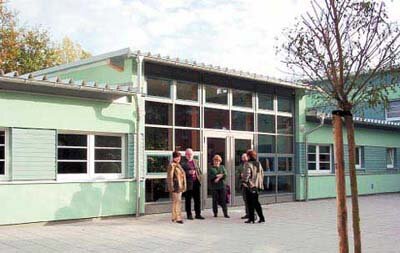 |
Former day-care nursery in the Turower Straße quarter converted into a Socio-Cultural Centre (Source: IRS, Erkner) |
Taking account of residents' wishes and ideas, another focal point of action is the safeguarding and improvement of ecological quality for "green living." In addition, local social self-help, the bundling of all resources for strengthening the local economy and local labour market initiatives, and, not least of all, efforts to improve the image of the district all contribute to integrative development.
4. Key Projects 
The first "Socially Integrative City" venture - and key project - in Sachsendorf-Madlow is the conversion of a former day-care nursery into a Socio-Cultural Centre. The building is located in the core area of the oldest and so far scarcely rehabilitated neighbourhood. The project represents the beginning of the comprehensive remodelling of the entire neighbourhood, including the modernisation of dwellings, partial demolition, and improvement of the residential environment. Building work began in October 2000, being carried out not only by local firms but also by a number of people employed under a "work not social assistance (ASS)" project.
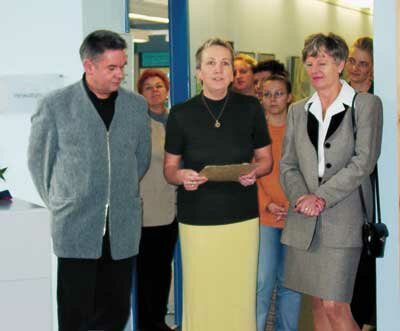 |
Opening of the Socio-Cultural Centre on 25th October 2001 (Source: IRS, Erkner) |
The establishment of a Socio-Cultural Centre has created a contact and meeting point as well as a venue for events within the neighbourhood at the disposal of local residents, clubs, associations, and civic action groups. Besides social, psycho-social, and cultural facilities like a theatre rehearsal stage, space is available for temporary cultural events. Residents can also use multi-purpose rooms at a reasonable price, for example, for family celebrations. The "Network For Each Other - With Each Other" and the "Volunteer Agency" aim to link up existing action groups in the district and activate residents. The strong interest and large number of visitors since the opening in October 2001 indicate the positive response this project has found.
5. Organisation and Management 
Since 1997, various integrative organisational and management structures have already come into being in Sachsendorf-Madlow in the course of implementing the development programme "Further Development of Large New Housing Areas." This established the basis for putting the "Socially Integrative City" programme into effect. Even if cooperation between actors was initially difficult, a procedure culture has meanwhile developed that includes all levels of participation. At the end of 2001, most of the model area was designated an urban renewal area, thus redefining the tasks to be undertaken, which is also reflected in organisational structures.
The Building Administration Office is the competent authority in the municipality, being in charge of implementing both the "Socially Integrative City" and "Further Development of Large New Housing Areas" programmes, and of coordination within the municipality. The office is also responsible for intermediary and local actors.
Process coordination, organisation of the public discourse, and management of investment measures have so far been entrusted to the area commissioner at the intermediary level (cooperation between StadtBüro Hunger and Deutsche Stadt- und Grundstücksentwicklungsgesellschaft (DSK)) and are in future to be in the hands of the urban renewal agent.
The district management aims to link up the work of local authorities, investors, social institutions, and residents more closely and to improve the integration of various lines of action. Assignment of this mediating function, which needs a high degree of flexibility and independence, to the municipality proved unsuccessful after a brief trial period. In future an actor independent of the administration and owners will be entrusted with the task.
To permit competent participation by citizens and local actors, they are given support under the "Socially Integrative City" programme and included in various planning and decision-making bodies. A particularly important role in decision-making in the district is played by the Citizens' Association as the "spokesperson" of residents and by the "Network For Each Other - With Each Other" because of the contribution it makes to networking district actors.
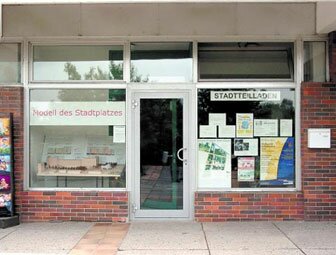 |
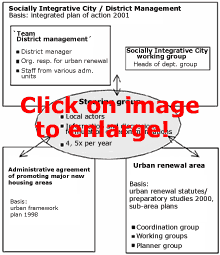 |
| District Centre in Gelsenkirchener Allee (Source: IRS, Erkner) |
Socially Integrative City / District Management |
The different levels and participation structures have so far been brought together in the steering groups that have been meeting regularly in the District Centre (Stadtteilladen), and in the working parties that have emerged from them, or in the superordinate coordination group. In future the steering group will be in the nature of an information and discussion body where local actors can contribute and offer recommendations to all actors on further action. Representatives of various administrative units and the district management, the urban renewal agent, the housing industry, the Citizens' Association, the International Building Exhibition, and the local higher educational institutions are to take part in the generally public meetings. Guests are to be invited to participate when the issue on hand so requires.
6. Activation, Participation, and Public Relations 
Conditions in Sachsendorf-Madlow are favourable for the activation and participation of local residents. Because of the residential tradition shared by a large proportion of residents, well-developed informal networks exist to provide the necessary basis. Moreover, the more than 80 active clubs, associations, organisations, and private institutions located in the district offer a wide range of amenities and activities for all age groups and areas of interest through which a large part of the population can be reached. The citizens' meetings and information events that have so far been organised, as well as the work of the Socio-Cultural Centre show that even without for-reaching activating forms of work it is possible to involve large sections of the local population in activities for the district.
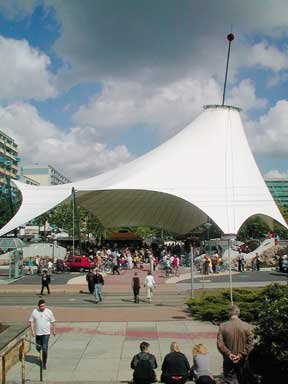 |
Opening of the redesigned District Square at the citizens' festival 2001 (Source: Der Sachsendorfer, Cottbus) |
Nonetheless, targeted activation work is indispensable to establish a broad participation culture. With the setting up of a district management, the foundation stone has been laid. In future greater emphasis will be placed on outreach and targeted participation work and broad public relations efforts, e.g., through collaboration on the much-read district newspaper and through other print media, as well as the Internet. As in the past, the annual district festivals organised by the Citizens' Association and citizens' meetings on issues important for the district, at the moment housing redevelopment, in particular, will be key components of the participation culture. The working groups that have formed in recent years in the framework planning process are to be maintained and the outcomes of their endeavours integrated actively into development of the district. However, much remains to be done to publicise the district and to improve its image. This is one of the key tasks of the "Network For Each Other - With Each Other." With the help of the local social services office, existing structures for the development of the district are to be turned to better account in the course of the "Socially Integrative City" programme.
The Socio-Cultural Centre funded by the "Socially Integrative City" programme and the "District Centre" in the heart of the district are the local contact points and information sources for residents.
7. Conclusion: Between Demolition and a Qualitative Relaunch 
At the present point in time, any final conclusion on the effectiveness of the "Socially Integrative City" programme would be premature. The social and economic measures, in particular, and medium and long-term in nature. Even now it is apparent that their success, especially the generation of a new, integrative planning culture, lies in the sustainability of their impact. There were obvious teething troubles. Municipal actors and the housing industry - under strong economic pressure - had difficulty at first in assessing the opportunities offered by the "Socially Integrative City" approach. There has meanwhile been a shift in emphasis. Better cooperation between administrative authorities, actors, and the population has been achieved, based on, for example, resident participation, greater consideration of everyday problems, labour market measures, and competent neighbourhood (process) management.
The projects and developments embarked on under the "Socially Integrative City" programme are an important step towards establishing sustainable structures in the district. Combining the two programmes "Socially Integrative City" and the new "Eastern Urban Redevelopment - Liveable Cities and Attractive Housing" offers an additional chance to achieve a new balance between social diversity and cohesion in a neighbourhood susceptible to constructional remodelling.
In recent times, the approaches chosen in Sachsendorf-Madlow in the context of the integrative plan of action have shown a marked enhancement of residents' power of articulation and greater involvement in developments. This is especially apparent in institutions like the Socio-Cultural Centre, in discussions in the District Centre, in the work of the "Network For Each Other - With Each Other" and at information and participatory events. The setting up of a district management has provided a key instrument for activation and participation, and for promoting integrative action.
The outcome of all efforts undertaken for district renewal remains to be seen. The outmigration that has been taking place since 1993 has not been stopped. On the contrary, it rose again last year and is increasingly associated with social segregation. Cottbus' urban redevelopment planning will need to react frankly and flexibly to this dynamic while offering reliable planning and implementation sequencing. The process of integrative socio-economic and constructional stabilisation at a high level that has just begun will continue to need continuity in cross-authority action by the municipality in partnership with residents and economic actors, especially the housing industry.
Im Auftrag des BMVBS vertreten durch das BBR. Zuletzt geändert am 25.05.2005